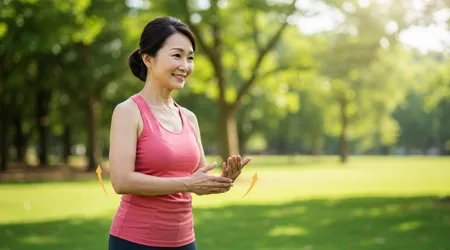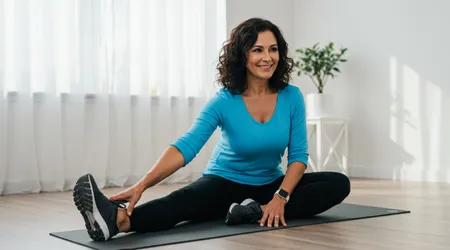The Best Low-Impact Workouts to Ease Joint Pain in Menopause

Workouts to ease joint pain in menopause are a lifeline for women navigating the choppy waters of hormonal change.
Anúncios
Menopause, typically striking between 45 and 55, brings a cascade of physical shifts hot flashes, mood swings, and, for many, nagging joint pain.
This discomfort, often tied to dwindling estrogen levels, can make daily movements feel like wading through molasses.
But here’s the good news: low-impact exercise offers a gentle yet powerful way to soothe aching joints, boost mobility, and reclaim vitality.
Why let joint pain dictate your rhythm when you can move smarter? This article dives into the best workouts to ease joint pain in menopause, blending science, practical tips, and creative strategies to keep you active and empowered in 2025.
Anúncios
Joint pain during menopause, known as menopausal arthralgia, affects over 50% of women, according to a 2023 study in Menopause journal.
Estrogen’s decline reduces cartilage protection and fuels inflammation, leaving joints stiff and sore. High-impact exercises like running can worsen this, but low-impact alternatives think swimming, yoga, or cycling nurture joint health without strain.
These activities lubricate joints, strengthen supporting muscles, and enhance flexibility. Beyond physical relief, they spark endorphins, easing stress and uplifting mood, which menopause can often dampen.
This guide curates the most effective workouts to ease joint pain in menopause, tailored for accessibility and long-term wellness.
Why Low-Impact Workouts Are a Game-Changer
Estrogen’s role in joint health is like a conductor in an orchestra when it fades, the harmony falters. Low estrogen increases inflammation, weakening cartilage and connective tissues.
Low-impact workouts, unlike jarring activities, minimize stress on joints while maximizing benefits. They promote synovial fluid circulation, which lubricates joints like oil in a machine.
Regular movement also counters osteoporosis risk, a concern post-menopause, by stimulating bone-forming cells. These exercises are gentle enough for daily practice, making them ideal for women seeking sustainable relief.
Consider Sarah, a 52-year-old teacher who felt her knees protest during walks. She switched to swimming, a low-impact gem, and within weeks, her stiffness eased.
Swimming supports the body’s weight, reducing joint pressure while engaging muscles. This isn’t just anecdotal research from Hinge Health (2025) shows low-impact exercise cuts menopausal joint pain by up to 68% in 12 weeks.
++ Plant-Based Remedies for Hot Flashes That Actually Work
Such workouts also improve sleep and mood, tackling menopause’s broader symptoms. They’re not a cure-all, but they’re a cornerstone for resilience.
Low-impact doesn’t mean low effort. These exercises challenge muscles and cardiovascular health without punishing joints. For women in menopause, this balance is critical too much intensity risks injury, too little stalls progress.
Activities like Pilates or tai chi build core strength and balance, reducing fall risks, which climb post-menopause.
By prioritizing controlled movements, these workouts foster long-term joint stability, letting you move with confidence and grace.

Top Low-Impact Workouts for Joint Pain Relief
Swimming: The Ultimate Joint-Soothing Exercise
Imagine gliding through water, weightless, with every stroke easing your joints. Swimming is a stellar choice among workouts to ease joint pain in menopause.
The water’s buoyancy supports your body, slashing joint stress while working major muscle groups. It’s a full-body workout that boosts heart health without the pounding of running.
A 2024 Health & Her study found swimming reduces menopausal depression and anxiety, alongside joint pain, by improving circulation and muscle strength.
Also read: How to Manage Night Sweats Without Disrupting Sleep
Try a 30-minute swim session three times weekly. Start with freestyle laps, then mix in backstroke to vary muscle engagement. If pools intimidate, water aerobics offers similar benefits in a social setting.
Sarah, our teacher, joined a local aqua class and found camaraderie amplified her motivation. Warm water pools, around 80–85°F, further relax stiff joints. Always warm up with gentle stretches to prevent muscle strain before diving in.
Consistency matters more than intensity here. Even 15-minute sessions can lubricate joints and ease stiffness over time. For beginners, use a kickboard to focus on leg strength without overtaxing arms.
Swimming’s low-impact nature makes it forgiving, but proper form prevents shoulder strain. Consult a coach or physical therapist to refine technique, ensuring every stroke supports your joint health.
Yoga: Flexibility and Mindfulness in Motion
Yoga is like a warm hug for your joints, blending gentle stretches with mindfulness. Among workouts to ease joint pain in menopause, it shines for its adaptability.
Poses like Cat-Cow or Child’s Pose stretch tight muscles, while deep breathing calms the nervous system, reducing pain perception.
Yoga also counters menopause-related anxiety, a bonus for emotional wellness. A 2023 Bupa report notes yoga improves flexibility and balance, cutting fall risks.
Start with a beginner-friendly Hatha or restorative yoga class, focusing on poses like Downward Dog or Warrior II. These strengthen muscles around joints without overloading them.
Read more: Journaling Prompts to Understand Your Menopause Emotions
Use props like blocks or straps to ease into poses safely. Maria, a 48-year-old nurse, found 20-minute morning yoga sessions reduced her knee pain and boosted her energy. Online platforms like Yoga With Adriene offer free, menopause-friendly routines for home practice.
Avoid pushing into painful poses listen to your body. Restorative yoga, with longer holds and bolster support, is especially kind to sore joints.
Aim for two to three sessions weekly, gradually increasing duration. Pair yoga with meditation to amplify stress relief, as chronic stress can worsen joint pain.
This holistic approach nurtures both body and mind, making yoga a menopause must-do.
Pilates: Core Strength for Joint Stability
Pilates is a precision-driven ally in workouts to ease joint pain in menopause. By targeting core and stabilizing muscles, it supports joints like a scaffold.
Mat-based Pilates, using body weight, is gentler than reformer classes, ideal for beginners. It enhances posture and balance, critical as menopause heightens fall risks.
My Menopause Centre (2024) highlights Pilates’ role in reducing back pain and improving alignment.
Begin with a 20-minute mat session, focusing on moves like the Hundred or Pelvic Curl. These build core strength without joint strain. Use a cushioned mat for comfort, and consider online classes for guidance.
Maria added Pilates twice weekly, noticing less hip pain after a month. Small, controlled movements prevent overexertion, making it safe for daily practice.
For variety, try Pilates with resistance bands, which add gentle strength training. Avoid high-intensity versions if joint pain flares.
Work with a certified instructor to ensure proper form, especially if you’re new. Pilates’ focus on alignment helps distribute weight evenly across joints, reducing wear and tear. It’s a long-term investment in mobility and confidence.
Cycling: Low-Impact Cardio for Joint Health
Picture pedaling through a park, wind in your hair, joints thanking you. Cycling, whether on a stationary bike or outdoors, ranks high in workouts to ease joint pain in menopause. It delivers cardiovascular benefits without jarring knees or hips.
Stationary bikes are especially forgiving, letting you control resistance and pace. A 2025 Hinge Health article notes cycling improves joint lubrication and muscle strength.
Aim for 20–30 minutes of moderate cycling three times weekly. Start with low resistance, gradually building intensity.
Outdoor cycling adds scenic motivation, but ensure a bike fit to avoid strain. Jane, a 50-year-old accountant, swapped jogging for cycling and saw her ankle pain drop significantly. Indoor spin classes, often low-impact, offer community and structure.
Vary your routine with interval cycling alternate 2 minutes of faster pedaling with 1 minute of slow. This boosts heart health without overtaxing joints.
Always stretch calves and hamstrings post-ride to prevent tightness. Cycling’s rhythmic motion soothes joints while keeping you fit, making it a menopause-friendly staple.
Tai Chi: The Art of Flowing Movement

Tai chi, with its slow, deliberate movements, is like a dance for your joints. It’s a standout in workouts to ease joint pain in menopause, blending balance, flexibility, and mindfulness.
Its gentle flow strengthens muscles and improves coordination, reducing fall risks. A 2024 Medical News Today article cites tai chi’s ability to enhance joint function and reduce stiffness.
Practice tai chi for 15–20 minutes daily, starting with basic forms like Wave Hands Like Clouds. Online tutorials or local classes guide beginners.
Jane found tai chi’s meditative pace eased her shoulder pain and stress. It’s accessible for all fitness levels, with no equipment needed. Focus on smooth transitions to protect joints.
Group classes foster connection, combating menopause-related isolation. Tai chi’s low-impact nature suits daily practice, but start slowly to master form.
Pair it with deep breathing to maximize relaxation. This ancient practice not only soothes joints but also restores a sense of calm and control.
Nutrition and Lifestyle Synergy for Joint Health
Exercise alone isn’t enough like a car, your body needs the right fuel. A diet rich in omega-3s (think salmon or walnuts) reduces inflammation, complementing workouts to ease joint pain in menopause.
The Better Menopause (2024) suggests 25 grams of daily fiber to curb inflammation. Avoid processed foods and excess alcohol, which can spike joint pain. Hydration is key aim for 8–10 cups of water daily to keep joints lubricated.
| Nutrient | Source | Benefit |
|---|---|---|
| Omega-3 Fatty Acids | Salmon, flaxseeds | Reduces joint inflammation |
| Vitamin D | Sunlight, fortified dairy | Supports bone health |
| Calcium | Kale, almonds | Strengthens bones |
| Fiber | Whole grains, berries | Lowers systemic inflammation |
Sleep and stress management amplify exercise benefits. Poor sleep, common in menopause, heightens pain sensitivity. Aim for 7–8 hours nightly, using relaxation techniques like meditation.
Stress, as Evernow (2023) notes, worsens joint pain. Try journaling or short walks to unwind. These habits create a holistic framework, making workouts more effective.
Supplements like glucosamine or curcumin may help, but evidence is mixed consult a doctor first. Hormone replacement therapy (HRT) can address estrogen-driven pain, per Online Menopause Centre (2023), but it’s not for everyone.
Combine these with workouts to ease joint pain in menopause for a multi-pronged approach. Small, consistent changes like adding spinach to meals or a 10-minute stretch yield big results.
Practical Tips to Stay Motivated and Safe
Starting a new routine can feel like climbing a hill, but small steps lead to summits. Set SMART goals, like “I’ll swim 20 minutes twice weekly.”
Partner with a friend for accountability Jane and her neighbor cycled together, making it fun. Track progress in a journal to celebrate wins, like less knee stiffness. These tricks keep workouts to ease joint pain in menopause sustainable.
Listen to your body to avoid overdoing it. If a workout causes pain, scale back or try another, like switching from cycling to yoga.
Consult a physical therapist for personalized plans, especially if you have arthritis. Hinge Health (2025) emphasizes PT’s role in tailoring safe routines. Warm-ups and cool-downs, like 5-minute walks, prevent injury.
Incorporate variety to stay engaged alternate swimming with tai chi or Pilates. Online platforms like Peloton or local community centers offer low-impact classes.
Reward yourself with non-food treats, like a new yoga mat, to maintain momentum. These strategies ensure workouts to ease joint pain in menopause become a joyful habit, not a chore.
Conclusion: Embrace Movement, Reclaim Comfort
Menopause doesn’t have to mean living with joint pain. Workouts to ease joint pain in menopause, like swimming, yoga, Pilates, cycling, and tai chi, offer gentle paths to relief.
They lubricate joints, build strength, and lift mood, countering menopause’s challenges. Pair these with anti-inflammatory nutrition, good sleep, and stress management for a holistic boost.
Sarah and Jane’s stories show real women thriving through movement. Start small, stay consistent, and consult professionals to tailor your plan.
In 2025, let movement be your ally reclaim your body’s rhythm and dance through menopause with ease.
Frequently Asked Questions
Can low-impact workouts really reduce joint pain during menopause?
Yes, low-impact exercises like swimming and yoga lubricate joints, reduce inflammation, and strengthen muscles, easing pain, per Hinge Health (2025).
How often should I exercise to see results?
Aim for 150 minutes of moderate low-impact activity weekly, with 2–3 strength sessions, as recommended by Bupa (2023).
Are supplements necessary for joint pain relief?
Supplements like omega-3s may help, but evidence varies. Consult a doctor to ensure safety, especially with medications (The Better Menopause, 2024).
What if I have arthritis alongside menopausal joint pain?
Low-impact workouts are still beneficial but consult a physical therapist for tailored exercises to avoid aggravating arthritis (Medical News Today, 2025).
